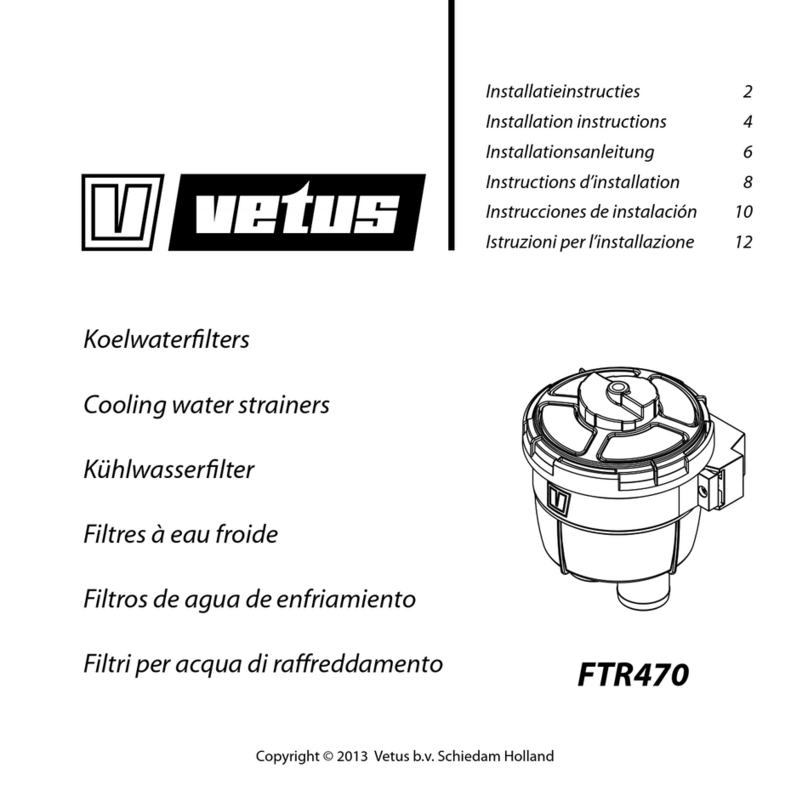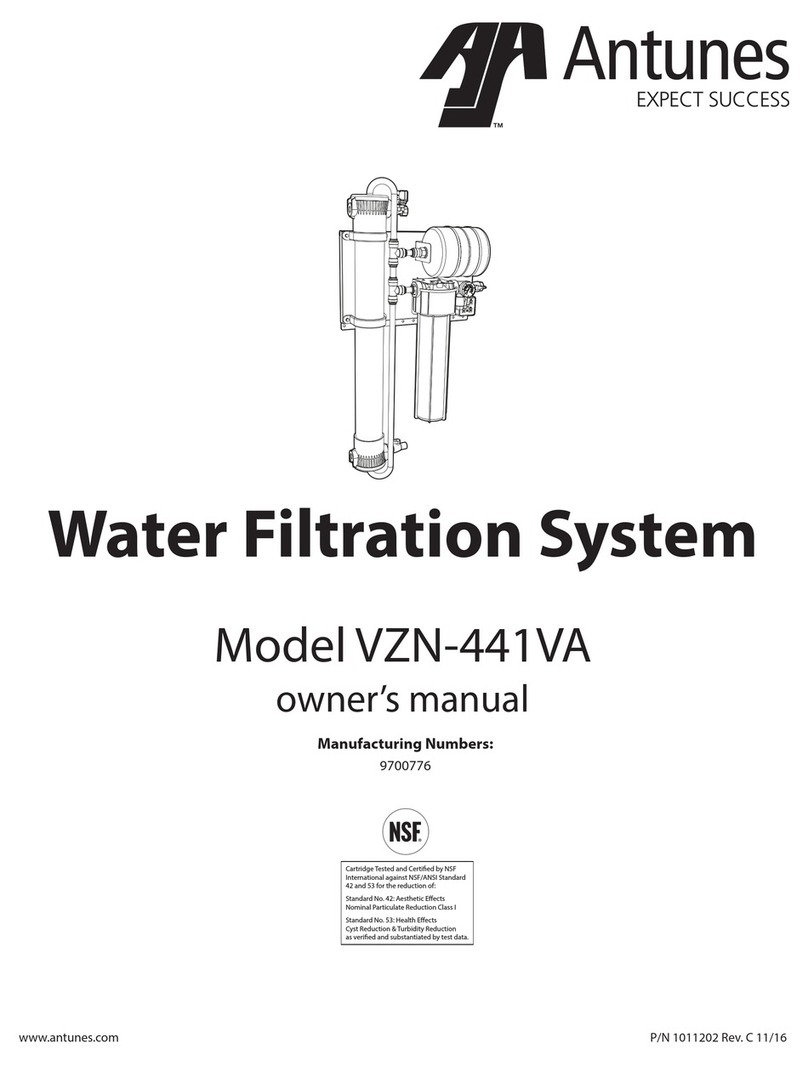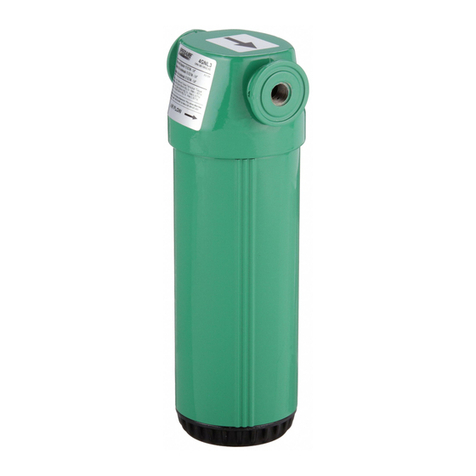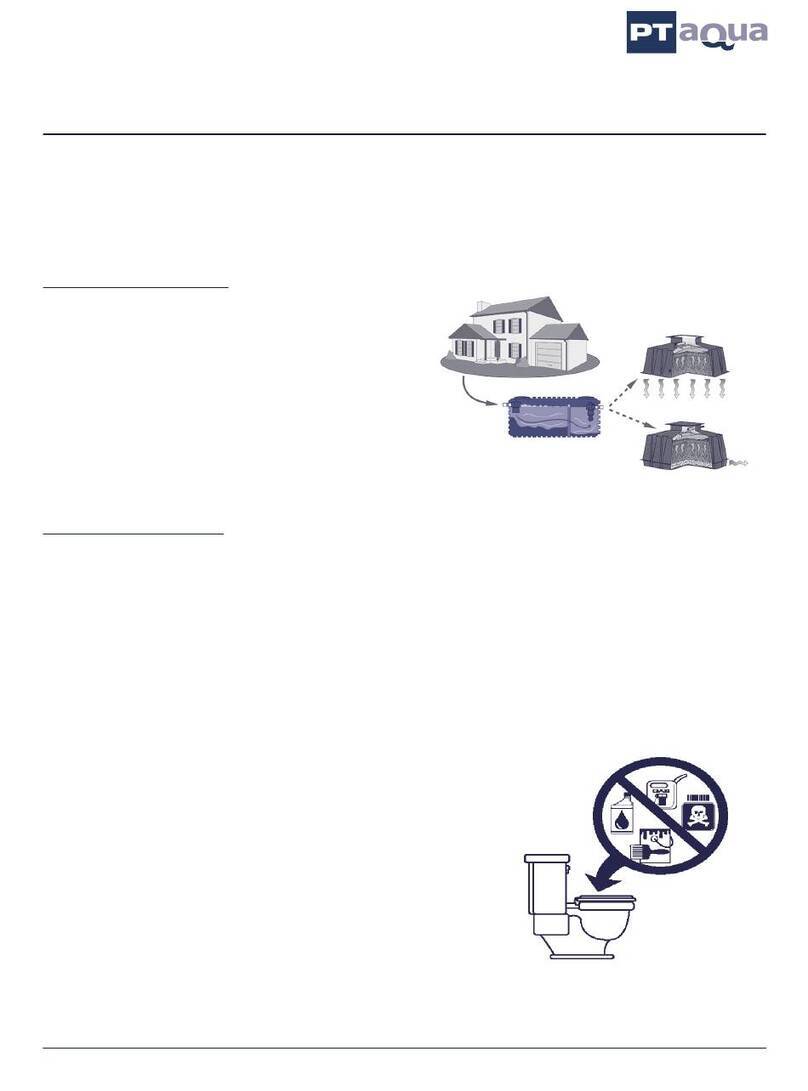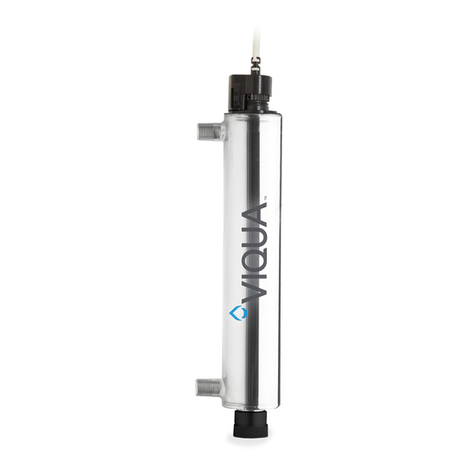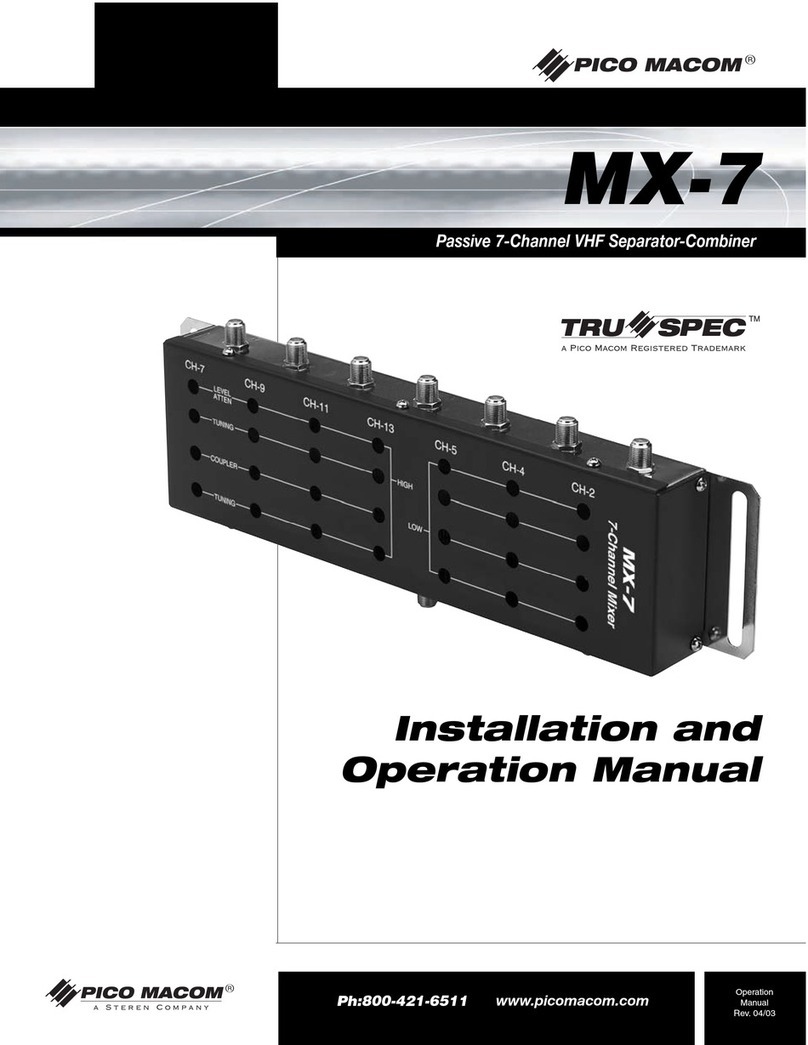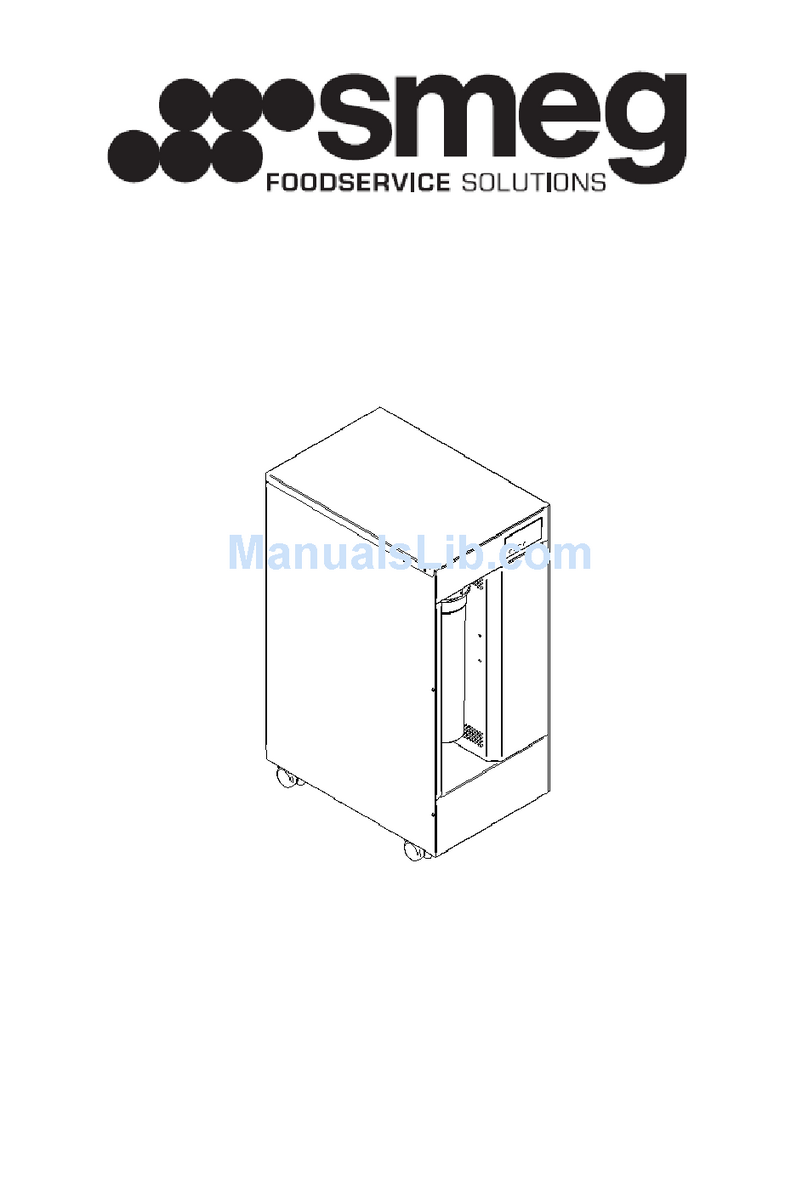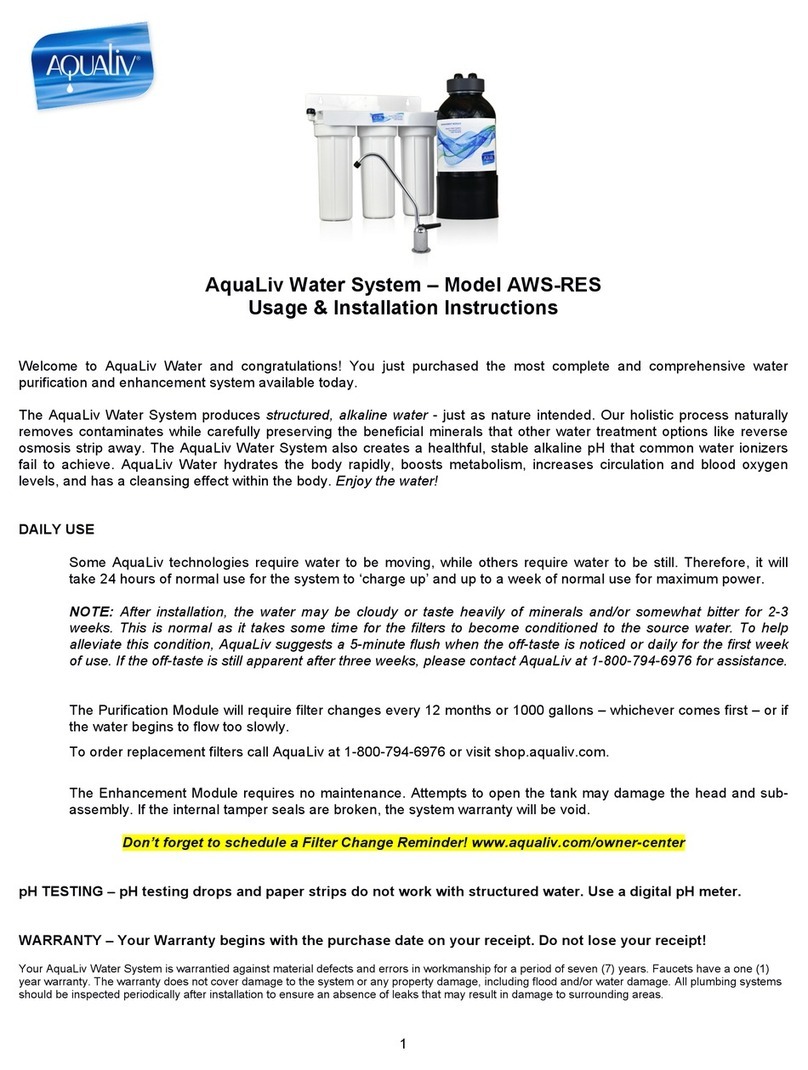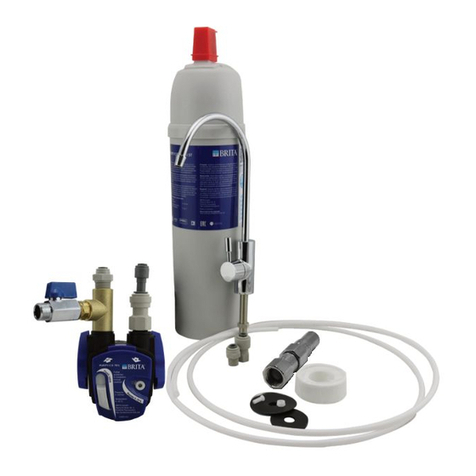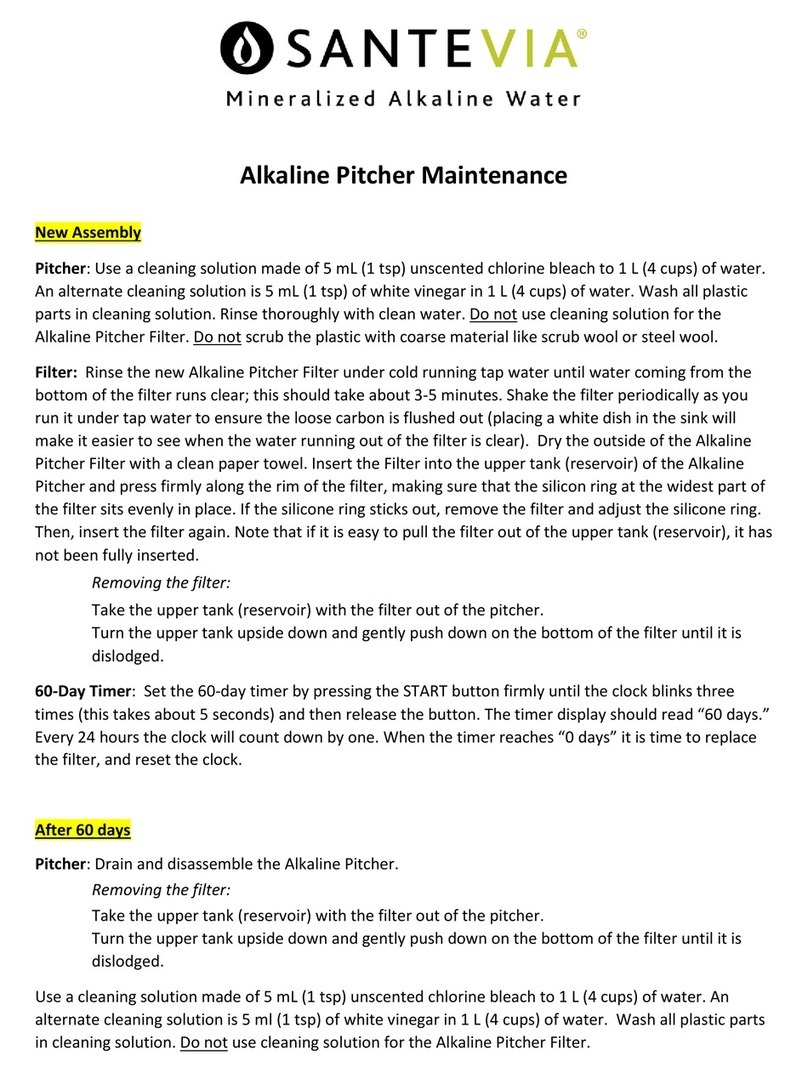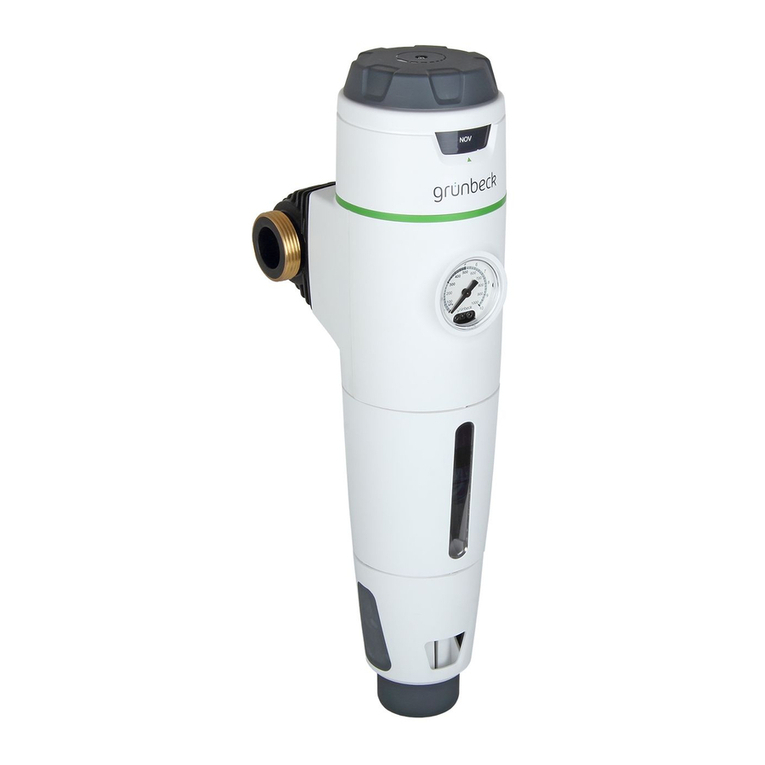Charger HydroSplash CWISO475PA Quick start guide

HydroSplash
Reverse Osmosis Undersink Water
Filtration System
Owners Installation Manual
Model: CWISO475PA/NF/CHPL

The Charger HydroSplash RO system is made with quality components to provide
cleaner, safer drinking water. No chemicals are added or used in this system.

Table of Contents
i. Notice
ii. Parts List
1.0 Introduction pg. 1
2.0 Installation pg. 2
2.1 Location of RO Unit pg. 2
2.2 Mounting the RO filter Unit Under a Sink pg. 3
2.3 Connecting the Feed Water Supply pg. 4
2.4 Installation of non UPC Drain Connection pg. 5
2.5 Installation of Clean Water Faucet pg. 5
2.6 Porcelain/Enamel Over Steel or Cast Iron Sinks pg. 6
2.7 Install Faucet pg. 7
2.8 Tubing Connections pg. 8
2.9 Air Gap Faucet Installation pg.10
3.0 System Start Up pg. 11
3.1 Air Purge pg. 11
3.2 Start-Up pg. 11
4.0 Recommended Filter Changes pg. 12
pg. 12
4.1 Filter Replacement for 5-stage HydroSplash
4.2 Filter Replacement for 4-stage HydroSplash pg. 12
5.0 Filter Replacement Procedure pg. 13
6.0 Conditions of Use pg. 13
7.0 Installation Troubleshooting pg. 13
8.0 Two-Year Limited Warranty pg. 14
9.0 Performance Data Sheet pg. 15
9.1 Arsenic Facts pg. 16
Appendix A: Theory of Operation pg. 17
A.1 Pre Filters pg. 17
A.2 The Reverse Osmosis Membrane pg. 17
A.3 Auto Control pg. 18

i NOTICE
This instruction manual was written to guide a professional plumber to make an easy
installation of the Charger HydroSplash. The installation shall conform to state and local
laws and regulations.
This manual covers the HydroSplash system with 75 gallon per day membranes.
This filter system can be installed by the homeowner who has sufficient tools and skills.
Be cautioned that an extra faucet for purified water will be installed . This requires a 7/8-
inch diameter hole in the sink top. If there is not an extra hole existing, a new one must be
drilled. For a porcelain sink, this requires a special drill (7/8” Relton cutter) which costs
about $200 and requires skill to use.
ii PARTS LIST
Parts contained in the Charger HydroSplash carton:
1-Box containing storage tank
1-Box with filter assembly
1-Set of orange, white and black plastic tubes
1-clean water faucet and fittings
1-set of installation hardware

– 1 –
1.0 INTRODUCTION
The Charger HydroSplash is a 4 or 5-stage water cleansing system. The 5-stage
system is identical to the 4-stage; with an additional carbon prefilter. For simplicity, this
manual will be referencing the 5-stage system. The principle cleansing of the water of
its dissolved solids is performed by the Reverse Osmosis membrane filter (Stage 4).
Stage One is a sediment filter that removes particles 5-microns in size or larger
including rust, sand and other debris in the water line.
Stage Two and Three are granular activated carbon (GAC) filters that remove odors,
chlorine and foreign tastes.
Stage Four is an advanced Reverse Osmosis membrane for removal of dissolved
solids. This is the heart of the system. Reverse Osmosis technology removes 95% of
the dissolved solids on average. Dissolved solids are not removed by municipal water
treatment, That is why the HydroSplash is an important safety factor for the water you
drink and use in your cooking. Chemical contaminants such as mercury, lead and
others not yet identified that seep into municipal water systems are removed.
The water pressure forces the water molecules through the Reverse Osmosis
membrane, but the larger contaminant molecules do not pass through the membrane
and are flushed to the drain. The clean water goes to the storage tank and is held there
ready to use.
Stage Five (post-filter) is a Carbon polishing filter that removes any foreign tastes or
odors that may occur from storing the water. The storage tank is pre-pressurized with
a bladder that pushes the water through Stage Five to the faucet. When the faucet is
opened, clean water from the storage tank flows through this final polishing filter of
activated carbon and into the faucet for your use.
A special faucet is installed on your sink which dispenses safe, great tasting drinking
water, which is especially good for making coee, tea and drinks. By extending a line to
your refrigerator, this water can also be used to make ice cubes.
Filter Life Span
Charger recommends changing the pre and post filters once every year, and the
Reverse Osmosis membrane every 3 years.

– 2 –
2.0 INSTALLATION
2.1
2.2
Before starting the installation, you should measure the water pressure that is
available under the sink to power the HydroSplash RO. If the pressure is less
than 40-psig, it is too low; and if it is 90-psig, it may be too high. The solution
if the pressure is too low is to use a model with a booster pump. The solution
for high water pressure, is to put a pressure regulator in the inlet water line to
the house. A pressure of 60-75 psig is normal.
Location of RO unit
The RO unit may be located under the kitchen sink or in the basement. A cold
water supply line must be close by. When locating the system under a sink
make sure there is adequate room for the filter module assembly as well as the
storage tank. For best performance the tank should be located as close to
the clean water faucet (supplied) as possible (within 20 feet).
Mounting the RO filter unit under a sink (Fig. 1.)
Mount the unit to the wall of the sink cabinet. Pre-fit the unit by positioning the
bottom of the pre-filter cartridges 2 inches o the floor of the cabinet. This
clearance is necessary to make room to remove the housings when replacing
the filter cartridges. Mark the location of the 2 mounting holes in the mounting
bracket. Install 2 mounting screws leaving 1/8 inch clearance under the screw
head. Check the fit by mounting the RO filter unit but don’t install yet.
A 1/4" ball valve is supplied so the homeowner can easily shut o feed water
when leaving the home unattended. The best overall protection from potential
water leaks in the kitchen, hot water heater, or utility room is to install an
automatic leak detector shuto valve to the house.

– 3 –
Figure 1
Figure 2 RO SYSTEM TOP VIEW
Feed Water Line
Orange Tubing from Pre-Filters
Pure Water Line
White tubing
Drain Water Line
Black Tubing to Drain
To Clean Water Tank
Auto-Valve
(rotated 90 ° for clarity)
RO MEMBRANE
IN
OUT
Regular
Faucet
UPC Approved
Drain Connection
(Not included)
Slip Joint
AdapterI nstall
Ball Valve
Drain Line
(1/4” black tubing)
Tap Water Feed Line
to Pre-Filter
(1/4” orange tubing)
Post-Filter
Carbon
Sediment
Carbon
(5-stage only)
Drinking Water
Storage Tank
Drinking Water Line
to Storage Tank
(3/8” yellow tubing)
Drinking Water Line
from Post-Filter to Faucet
(3/8” white tubing)
Existing
Water Line
Clean Water
Faucet

– 4 –
2.3 Connecting the feed water supply (Figure 3)
The feed water assembly consists of 1/2” brass slip joint adapter, a black
washer, and a 1/4" x 1/4" ball valve. Locate these parts in the installation kit.
Locate the cold water shut o valve under the sink and turn it o. Open the
cold water faucet to release the pressure. On single handled faucets, the hot
water may have to be turned o to prevent any hot water cross-over. If water
continues to come out of the faucet with the under-sink valves turned o, the
house main valve will have to be turned o.
With the water turned o, disconnect the cold water riser tube (flex line) from
the valve. Install the slip joint connector with the black washer. Loosen the
nut and separate the cold riser tube from the faucet shank. Gently bend the
riser tube so that the slip joint adapter fits onto the faucet shank. Reinstall the
cold riser tube on the slip joint connector using the existing cone washer. For
Solid copper tube the procedure is the same except you must cut a piece
of the riser tube about 3/4” to 1” so the slip joint adapter can fit between the
valve and the riser tube. Wrap several turns of Teflon tape on the ball valve and
install on the slip joint connector.
Figure 3
Ball Valve Existing Cold Water
Line to Sink
Rubber Grommet
1/2" Slip Joint Adapter
Black Washer
Existing Cold Water Supply Valve
1/4" Tubing (orange)
Nut

– 5 –
2.4 Installation of Non-UPC drain connection (Figure 4)
Place the drain outlet saddle on the drain pipe. Allow proper space for the
drilling operation. Tighten the saddle bolts evenly on both sides. Using the
opening in the drain outlet saddle as a guide, drill a 1/4" hole in the drain pipe.
Clean any debris out of the drain saddle connection.
Figure 4
2.5 Installation of clean water faucet
The faucet should be positioned with aesthetics, function, and convenience
in mind. An ample flat area is required for the faucet base so that it can be
drawn down tight. The space under the sink below where the faucet will be
mounted must be clear of any obstructions.
Some conditions may eliminate the need to drill a hole in the sink such as a faucet
previously installed in the sink, a hole covered by a chrome hole cover, or an
unused spray handle. If any of these situations are present, you may mount the
faucet in one of these holes.
The sink drilling process is not complicated, but requires a certain amount
of caution and forethought. Porcelain sinks can be chipped if care is not
exercised when drilling the hole for the faucet.
Alternate drain connection where UPC is not required
Vertical Mount
Horizontal Mount
Disposal
Do not
mount here
Sink Sink
Maximum Displacement
from Top Center - 30”
RO Drain Line
Foam
Sealing Washer
1/4” Tube (black)
Compression
Fitting

– 6 –
2.6 Porcelain/Enamel over Steel or Cast Iron Sinks
Using a small diameter carbide tipped drill, drill a pilot hole completely
through the porcelain and the material underneath. Remove any metal chips
that fall into the sink to prevent rust stains. Place the spring-loaded porcelain
cutter bit in to the drill chuck. Make sure the pilot guide is inserted tightly.
Insert the pilot guide onto the pilot hole. Push down gently on the drill motor
to apply light pressure to the porcelain surface. Start the drill motor, turning
as slowly as possible. After the initial cut has started, motor speed may be
gradually increased. The cut may require three to four minutes to complete.
Going faster could result in excessive chipping. Be sure a complete ring has
been cut through the porcelain to the metal underneath.
Place the finish hole saw into the drill chuck. Make sure the pilot guide is
inserted tightly. Insert the pilot guide into the pilot hole. Begin cut using a
slow speed and light pressure until the porcelain has been penetrated to
the material underneath. Remove the saw from the hole and clean all debris
from the porcelain surface. Reinsert saw into the hole and cut through the
remaining material.
[NOTE: This procedure is for the non air gap faucet provided.]
Figure 5 Step 1.
Pilot Drill
Step 2.
Spring loaded
porcelain saw
(Relton cutter)
Step 3.
Finish hole saw

– 7 –
2.7 Install Faucet (Figure 6)
Disassemble the hardware from the threaded stud except for the top base
plate and sealing gasket. Install the faucet in the sink hole. From below the sink
assemble the mounting hardware. Use a deep socket to tighten the nut.
Figure 6
Escutcheon Plate
Small Rubber Washer
Counter Top
Lock Washer
Faucet Adapter
3/8” Tubing (white)
Nut
Black Rubber Washer
Black Locating Washer
(used where a 1/2” hole is
available, reverse when
mounting on stainless steel
or when using drilled hole)

– 8 –
2.8 Tubing Connections (Figure 7)
a. The standard tubing connections on the HydroSplash are of Quick
Connect O-ring seal design and manufacture. Use the tubing and follow the
instructions in Figure 8 to make the connections. If you cut the tubing, make
sure it is a square cut and that the tubing fits evenly in the fitting and seals
properly.

– 9 –
b. Feed Water Line
Connect the orange colored 1/4” inlet tubing to the ball valve, or saddle valve
installed in Step 2.3 above. To reduce the water hammer eect on this fitting,
make a large loop in the tubing before the connection on the sediment filter.
To connect, remove compression nut insert tube over the ball valve tube as
shown in Figure 3. Slide nut over threads and tighten. Connect the other end
of the tube to the inlet fitting using the method as described in Section 2.8
c. Drain Line
Find the black colored 1/4” tubing. Connect the tube to the drain saddle
clamp from Step 2.4. Push the tube into the fitting about 1/2 inch. Tighten
plastic nut.
d. Faucet Line
Screw the faucet adapter on to the end of the faucet. Find the white colored
3/8” tubing and insert into the quick connect fitting as described in Section
2.8a. Connect the end of the tube to the quick connect fitting on the post
filter (stage 5). Push the tube into the fitting until it stops.
e. Tank Line
Install the plastic ball valve on the storage tank. Find the yellow-colored 3/8”
tubing and connect the tube to the plastic ball valve on the tank. Push tube
into fitting until it stops. Connect the other end of the yellow tube to the
“T” fitting. The tank comes pre-charged from the factory at 5-7 psi. Double
check the pressure with a tire gage (the air fitting is on the opposite end of
the tank from the ball valve). If it is less than 5 psi add 2 psi with a compressor
or bicycle pump.
Note: Putting more pressure than 7 psi does not help to increase water flow
through the faucet.
Figure 7

– 10 –
2.9 Air-Gap Faucet Installation (Figure 8)
Air-Gap Faucets are sometimes required by municipal code. The faucet is
designed to take the waste water from the membrane to the top of the sink
and then let it flow by gravity to the drain saddle. The objective is to prevent
possible backup of drain water from the sink to the membrane in the event of
a sink clog. A drain saddle with 3/8" instead of 1/4" is used. An extra section
of 3/8" tubing (black) is used from the faucet to the drain.
Sink Preparation
Drill the appropriate size hole in the kitchen sink to accommodate the air-gap
faucet.
Drain Connection
Follow instructions of section 2.5 except drill a 3/8" hole in the drain pipe.
Tubing Connections
Find the black colored 1/4" drain line from the membrane. Connect this tube
to the 1/4" barbed fitting on the air-gap faucet.
Find the 3/8" black tubing in the parts kit. Connect this tube to the 3/8" barbed
fitting on the air-gap faucet. Install the faucet assembly (with tubes attached)
into the sink hole. Secure the faucet per instructions in section 2.8. Re-attach
the 1/4" black tubing to the drain side of the RO membrane housing. Attach
the 3/8" tube to the drain connector. Tighten the fitting nut securely. Attach the
pure water line to the faucet per the instructions in section 2.9-D.
Note: To reduce drain noise gently curve the black tubing from the air-gap
faucet to the drain connection.
Figure 8
Escutcheon Plate
Black Rubber Washer
Black Locating Washer
3/8” drain line
from Airgap to
Drainsaddle (blue)
Drain line 1/4” from RO
to Airgap (black) 3/8” Tubing (white)
Faucet Adapter
Nut
Lock Washer
Counter Top
Small Rubber Washer

– 11 –
3.0 System Start-Up
3.1 Air Purge
The filter elements of stage 1, 2 ,3, and 5 filters as shipped are dry and contain
air in the pores. The air will slowly be expelled but may collect in the system
and will need to be purged for peak operating eciency. Proceed with
Section 3.2 for air purge and initial start-up procedure.
3.2 Start-Up
Start the system by opening the feed water ball valve. Make sure the ball
valve on the storage tank is in the closed position. Check for leaks for at least
10 minutes. Open the product water faucet and let the water flow until all the
air has been expelled from the system. This will take about 30 minutes.
Close the product water faucet. Now open the tank valve. Let the system run
for about 2-hours to fill the storage tank. Then open the clean water faucet on
the sink and empty the tank. Dump and fill for a total of four times. This is to
flush the tank and remove the preservative from the RO membrane, as well as
carbon "fines" from the post filter that may have collected in the tank .
If the waste continues to run after the tank is full, it may mean there is air
binding the autovalve. Empty the tank again by opening the faucet. This will
help to clear more air from the system.

– 12 –
4.0 Recommended Filter Changes
4.1 Filter Replacement, Charger HydroSplash 5-Stage
Filter element replacements of Stage 1, 2, 3, and 5 are mandatory once a year
to maintain water purity.
To maintain the Platinum Seal Certification, only these replacement parts should
be used.
The recommended replacement frequency is listed below:
Sediment Filter Element, Stage 1
Pre-Carbon GAC Element, Stage 2
Pre-Carbon Filter Element, Stage 3
RO Membrane Assembly, Stage 4
Post Carbon Filter Element, Stage 5
Replacement Frequency
TF-4113-CHPL 6-12 Months
TF-4114-CHPL 6-12 Months
TF-4115-CHPL 6-12 Months
MP-4235 3-5 Years
TF-4115-CHPL 6-12 Months
These filter replacement elements and kits are available from your
DEALER. If not available, contact Charger for dealer information.
Charger Water, 8150 N. Lehigh Ave, Morton Grove, IL 60053
email: info@chargerwater.com
4.2 Filter Replacement, Charger HydroSplash 4-stage
Filter element replacements of Stage 1, 2 and 4 are mandatory once a year to
maintain water purity.
To maintain the Platinum Seal Certification, only these replacement parts should
be used. The recommended replacement frequency is listed below:
Replacement Frequency
6-12 Months
6-12 Months
3-5 Years
TF-4113-CHPL
TF-4115-CHPL
MP-4235
Sediment Filter Element, Stage 1
Pre-Carbon Filter Element, Stage 2
RO Membrane Assembly, Stage 3
Post Carbon Filter Element, Stage 4 TF-4115-CHPL 6-12 Months
These filter replacement elements are available from your dealer. When you
buy or install your Charger HydroSplash we recommend that you buy
the first year filter replacement kit.
This kit comes in a plastic bag which can be attached to the installed
Charger HydroSplash under your sink. There is a space to write in the date of
replacement, which is a maximum of a year from the date of installation. In the
replacement kit are instructions for replacement and cleaning.
At year 3 (or sooner if you have severe water problems), we recommend
that the reverse osmosis assembly be changed also. When you order your
third year kit from your Charger dealer, request the RO membrane assembly
along with the other filters.

– 13 –
5.0 Filter Replacement Procedure
The standard tubing connections on the Charger HydroSplash are of Quick Connect
O-ring seal design and manufacture. Use the tubing and follow the instructions in
Figure 8 to make the connections. If you cut the tubing, make sure it is a square cut
and that the tubing fits evenly in the fitting and seals properly. Turn o the feed water at
the feed water ball valve. Turn the storage tank ball valve to the o position and open
the faucet. This will depressurize the system. Put a shallow pan under the RO system to
catch any water that may spill during the operation.
Unscrew filter body (1/4 turn counter clockwise), pull down, and carefully lift it to the
sink to drain the remaining water. Discard spent filter body. To install new filter body
remove red cap from cartridge, lubricate both o-rings on filter stem using common
cooking oil or Vaseline then insert it into the head and turn 1/4 turn clockwise. Repeat
operation for all 3 pre-filters (for 4-stage system, only 2 pre-filters) and one post-filter.
6.0 Conditions Of Use
Water must be microbiologically safe. System pressure, 40 to 100 PSIG. Temperature,
40 to 100°F. pH range, 3 to 10. Maximum TDS, 1500 PPM. Maximum Iron (FE) 0.3ppm,
Maximum Manganese (Mn) .0.1ppm, Turbidity, less than 1.0 NTU.
7.0 Installation Troubleshooting
Problem Possible Cause Solution
• No or low water production. • Feed water shut o.
• Tank valve closed or partially
closed.
• Low feed pressure.
Feed pressure must by at
least 40 psi.
• Turn on feed water.
• Open tank valve.
• Increase inlet water pressure
or install booster pump if feed
water pressure is less than
40 psi.
• Leak at filter housing. • Defective or misaligned
O-ring.
• Shut o feed valve and tank
valve. Turn on faucet. Change
or realign O-ring.
• Leak at tube connection. • Not properly installed. • Tighten compression fitting
• Remove tube and re-install
into fitting.
• Bad-tasting water. • Post-filter cartridge not
flushed completely.
• Flush one or two tanks of
pure water through system.
• Water runs to drain all the
time.
• Auto-valve not closing
properly.
• Check valve not functioning
properly
• Purge the system again.
• Clean or replace check
valve
• RO Production good at
first but falls o in months or
weeks.
• High TDS and/or Iron and
Manganese.
• Consult your dealer or
Factory and provide water
analysis.

– 14 –
8.0 Two-Year Limited Warranty
Charger sells its products through independent water dealers who re-sell the
product to the end user.
Charger warrants the HydroSplash RO system to be free from defects in
materials and workmanship for a period of TWO YEARS from date of purchase.
This warranty does not cover damage resulting from accident, misuse, neglect,
improper installation, or subjection to water pressure in excess of 100 lbs. per
square inch. The warranty shall extend only to the original purchaser of the
product from a Charger dealer for use by the purchaser. Any modifications of
the product shall render the warranty invalid and Charger will have no further
responsibility. All warranty claims must be made to the Charger dealer from which
the product was purchased.
Charger shall in no event be liable for any incidental or consequential damages
of any kind; the sole obligation of Charger being limited to repair or
replacement of defective parts of product. Proof of purchase, date of purchase,
and name of dealer are required.
Any implied warranties herein are limited in duration to a period of two years from
the date of original purchase or the shortest period allowed by law.

– 15 –
9.0 Performance Data Sheet
Contaminant Reduction Typical RO
Influent Challenge Max permissible Minimum Average
Substance Concentration product water Percent (%) Percent (%)
mg/L concentration mg/L Reduction Reduction
Arsenic (+5) 0.30 ± 10% 0.010 98.1 99.0
Barium 10.0 ± 10% 2.0 95.0 98.8
Cadmium 0.03 ± 10% 0.005 94.0 98.3
Chromium (+6) 0.3 ± 10% 0.1 95.5 98.3
Chromium (+3) 0.3 ± 10% 0.1 98.4 99.0
Copper 3.0 ± 10% 1.3 95.0 98.4
Fluoride 8.0 ± 10% 1.5 87.0 93.8
Lead 0.15 ± 10% 0.010 90.4 96.8
Radium (226/228) 25 pCi/L 5 pCi/L 80.0 80.0
Selenium 0.10 ± 10% 0.05 94.4 97.9
TDS 750 ± 10% 187 88.0 92.2
Turbidity 11 ± 1 NTU 0.5 NTU 96.4 98.7
Model CWISO475PA
This system contains replaceable treatment components critical to eective reduction of TDS and eciency of the system. Replacement
of the reverse osmosis component should be with one of identical specifications, as defined by the manufacturer, to ensure the same
eciency and contaminant reduction performance. Replacement parts and numbers are shown below. The product water should be tested
periodically to verify that the system is performing satisfactorily in addition to making the parts replacement specified.
Recommended Changeout Interval
once each 3 years
once each year
once each year
once each year
RO Membrane Assembly 75 gpd, P/N MHA-4222
First stage sediment filter, 5-micron, P/N TF-4113
Second stage (5-stage only) granular activated carbon, P/N TF-4114-CHPL
Second stage activated carbon block, P/N TF-4115
Post filter, activated carbon block, P/N TF-4115
once each year
See OWNER INSTALLATION manual for complete installation/operation and maintenance requirements,
including manufacturer’s limited warranty.
This system can typically treat water containing pentavalent arsenic (also know as As(V), As(+5), or arsenate) at concentrations
of 0.30 mg/L or less. This system reduces pentavalent arsenic, but may not remove other forms of arsenic. This system is to
be used on water supplies containing a detectable free chlorine residual or on water supplies that have been demonstrated
to contain only pentavalent arsenic. Treatment with chloramines (combined chlorine) is not sufficient to ensure complete
conversion of trivalent arsenic to pentavalent arsenic. Please see the Arsenic Facts section of the Performance Data Sheet
for further information
ConformstoNSF/ANSI58forpentavalentarsenicreduction.See9.1arsenicfactssectionforanexplanationofreductionperformance.
Testing performed under under standard laboratory conditions. Actual performance may vary.
Specications
Pentair membrane 75 gallon per day reverse osmosis membrane
Storage tank: 4.0 gallon total volume; 2.2 gallon water volume
Dimensions: 14in. long by 6in. wide by 15.5in. high: Tank: 11in. dia by 15 1/2in. high Weight: 24 pounds
Conditions of Use
Do not use with water this is microbiologically unsafe, or of unknown quality, without adequate disinfection before or
after the system.
Pressure: Minimum-40psig: Maximum-100psig
Temperature: 40 to 100°F
pH Range = 3.0 to 10, max iron content - 0.3ppm
Turbidity of inlet water-less than 1.0 NTU, maximum TDS-1500ppm
-CHPL
-CHPL
-CHPL
MP-4235

– 16 –
9.1 Arsenic Facts
Arsenic (abbreviated As) is found naturally in some well water. Arsenic in water
has no color, taste, or odor. It must be measured by a laboratory test. Public
water utilities must have their water tested for arsenic. You can get the results
from your water utility. If you have your own well, you can have the water
tested. The local health department or state environmental health agency
can provide a list of certified labs. The cost is typically $15 to $30. Information
about arsenic in water can be found on the internet at the U.S. Environmental
Protection Agency website: www.epa.gov/safewater/arsenic.html.
There are two forms of arsenic: pentavalent arsenic (also called As(V), As(+5),
and arsenate) and trivalent arsenic (also called AS(III), As(+3), and arsenite).
In well water, arsenic may be pentavalent, trivalent, or a combination of both.
Special sampling procedures are needed for a lab to determine what type
and how much of each type of arsenic is in the water. Check with the labs in
your area to see if they can provide this type of service.
Reverse osmosis (RO) water treatment systems do not remove trivalent arsenic
from water very well. RO systems are very eective at removing pentavalent
arsenic. A free chlorine residual will rapidly convert trivalent arsenic to
pentavalent arsenic. Other water treatment chemicals such as ozone and
potassium permanganate will also change trivalent arsenic to pentavalent
arsenic. A combined chlorine residual (also called chloramine) may not
convert all the trivalent arsenic. If you get your water from a public water utility,
contact the utility to find out if free chlorine or combined chlorine is used in
the water system.
The HydroSplash systems are designed to remove pentavalent arsenic. They
will not convert trivalent arsenic to pentavalent arsenic. The system was tested
in a lab. Under testing conditions, the systems typically reduced 0.30 mg/L
(ppm) pentavalent arsenic to 0.010 mg/L (ppm) (the USEPA standard for
drinking water) or less. The performance of the system may be different at
your installation. Have the water tested for arsenic to check whether the
system is working properly.
The RO component in these systems must be replaced every 12 months or
when the test above rises above 10ppm to ensure the system will continue
to remove pentavalent arsenic. The component identification and locations
where you can purchase the component are listed in the installation/operation
manual.
This manual suits for next models
2
Table of contents
Other Charger Water Filtration System manuals
Popular Water Filtration System manuals by other brands
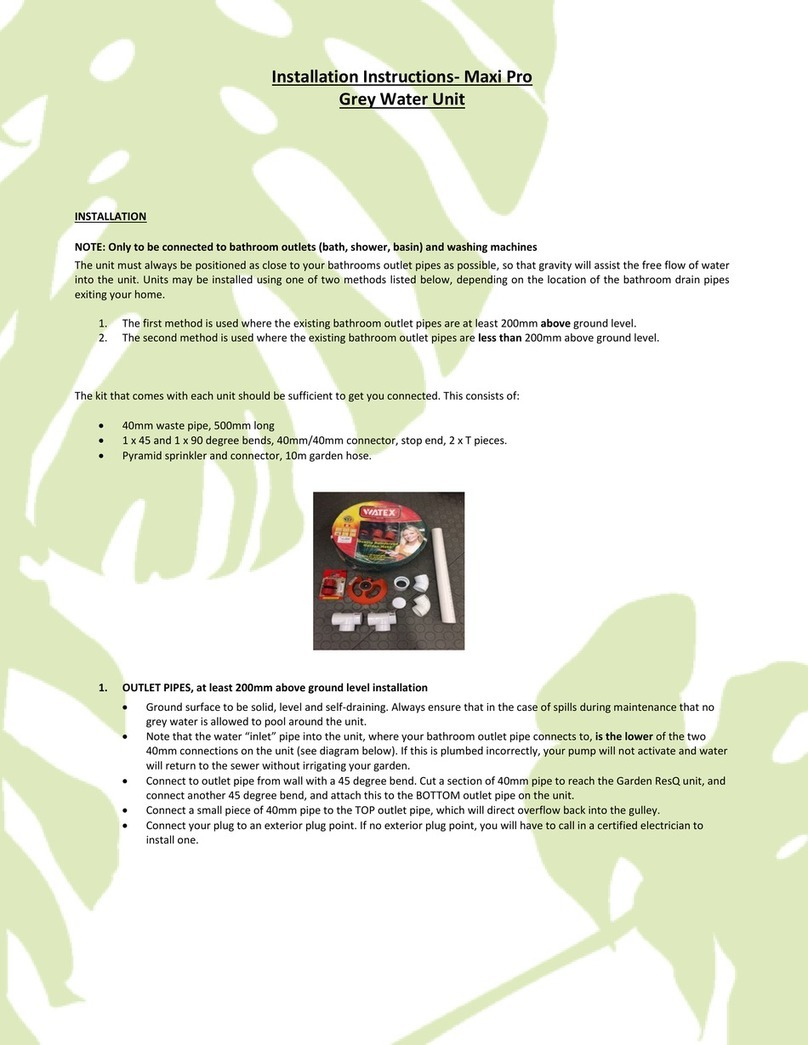
Garden ResQ
Garden ResQ Grey Water Maxi installation instructions
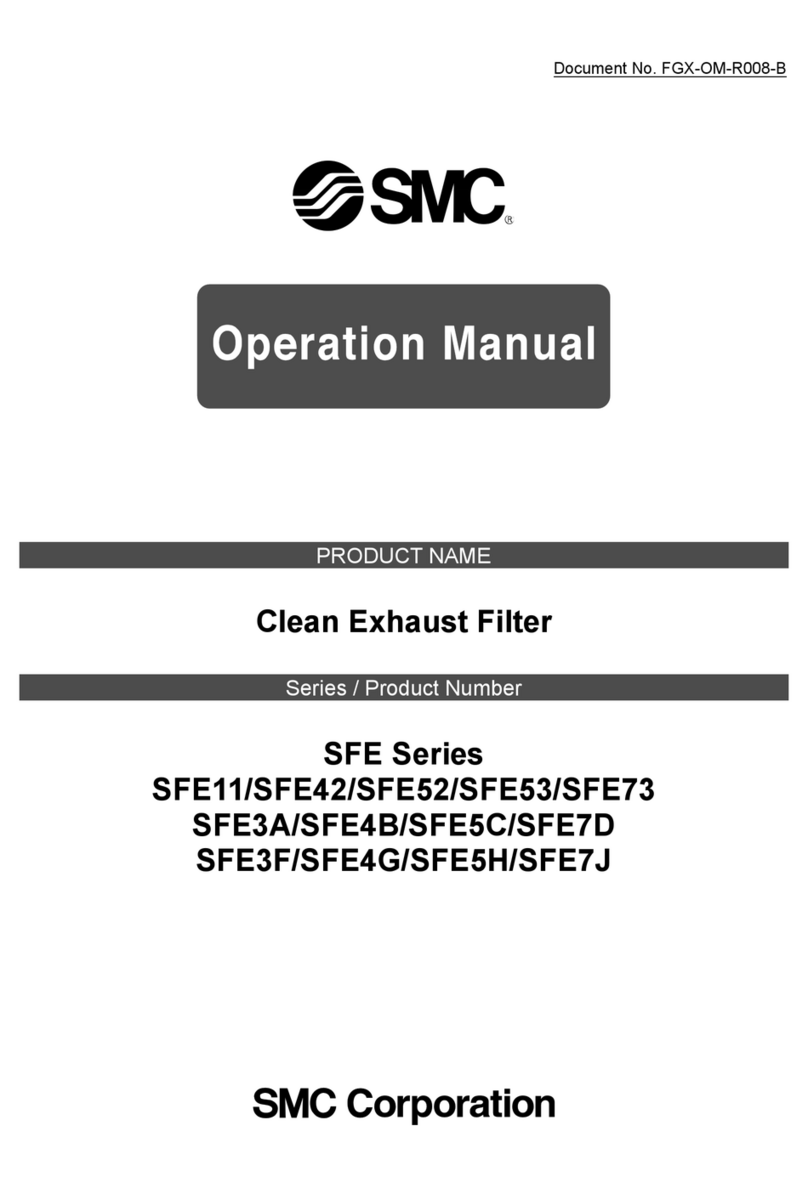
SMC Networks
SMC Networks SFE Series Operation manual
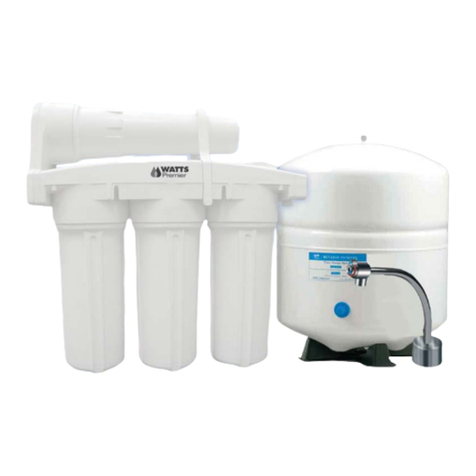
Premier
Premier WP-4 Installation, operation and maintenance manual
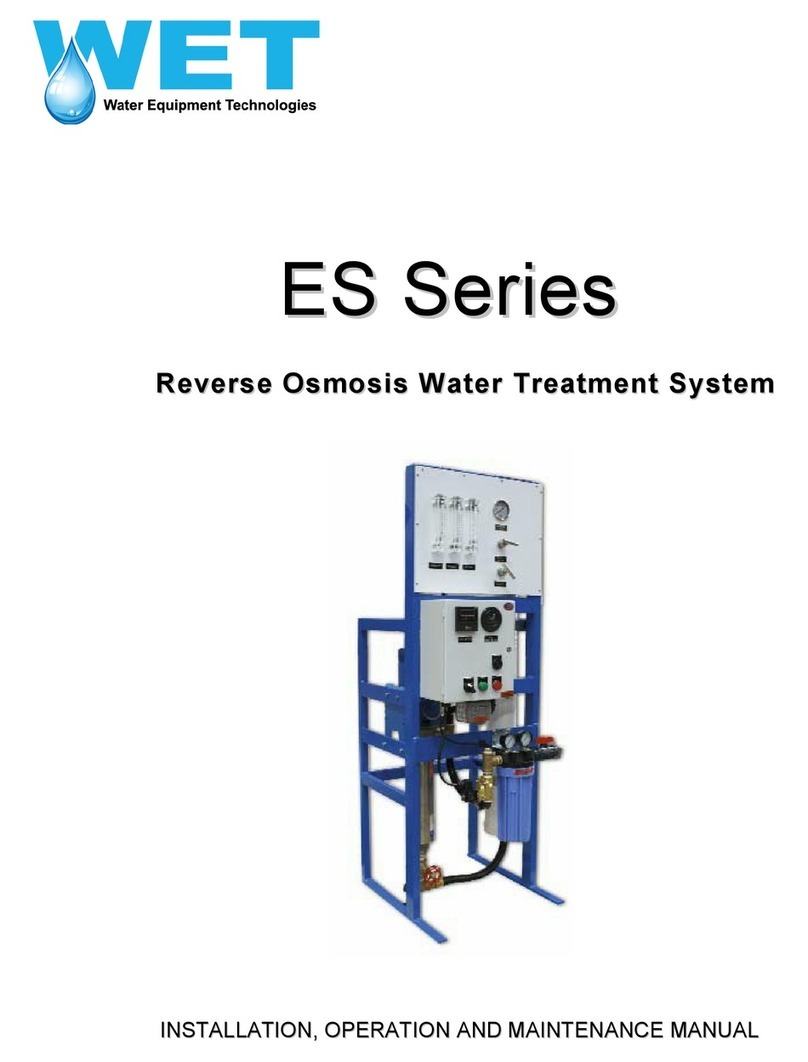
WET
WET ES Series Installation, operation and maintenance manual

NuvoH2O
NuvoH2O Home System installation manual
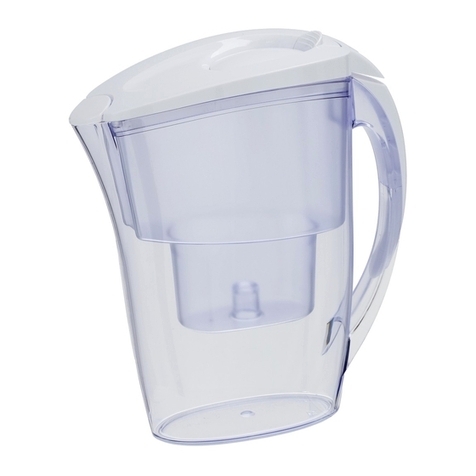
Xavax
Xavax 00111237 manual


